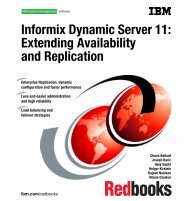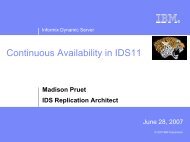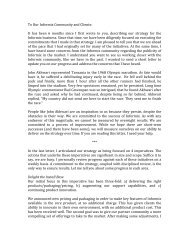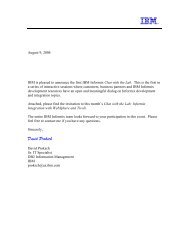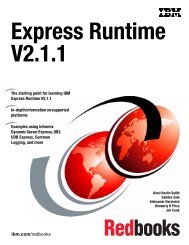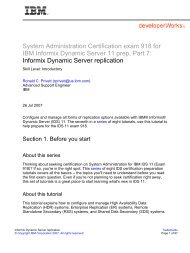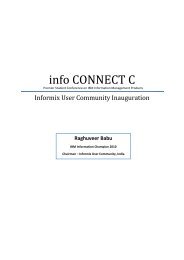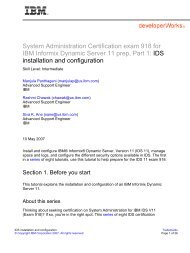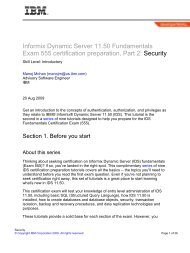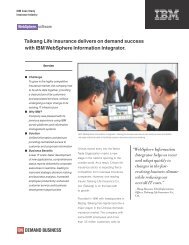Cheetah v11.10: Integrated Solutions and SQL ... - The Informix Zone
Cheetah v11.10: Integrated Solutions and SQL ... - The Informix Zone
Cheetah v11.10: Integrated Solutions and SQL ... - The Informix Zone
You also want an ePaper? Increase the reach of your titles
YUMPU automatically turns print PDFs into web optimized ePapers that Google loves.
IBM <strong>Informix</strong> Dynamic Server 11.10<br />
<strong>Integrated</strong> <strong>Solutions</strong> <strong>and</strong> <strong>SQL</strong> Enhancements<br />
IBM Information Management<br />
IBM <strong>Informix</strong> Dynamic Server (IDS)<br />
<strong>Cheetah</strong> <strong>v11.10</strong>:<br />
<strong>Integrated</strong> <strong>Solutions</strong> <strong>and</strong> <strong>SQL</strong><br />
Enhancements<br />
Author: Keshava Murthy<br />
Architect, IBM <strong>Informix</strong><br />
February 20, 2007<br />
Page 1
IBM <strong>Informix</strong> Dynamic Server 11.10<br />
<strong>Integrated</strong> <strong>Solutions</strong> <strong>and</strong> <strong>SQL</strong> Enhancements<br />
OVERVIEW.................................................................................................................................................................. 3<br />
INTEGRATED SOLUTIONS<br />
NAMED PARAMETERS SUPPORT FOR JDBC ...................................................................................................... 4<br />
ENHANCED CONCURRENCY WITH COMMITTED READ LAST COMMITTED ISOLATION LEVEL .5<br />
IMPROVED CONCURRENCY WITH PRIVATE MEMORY CACHES FOR VIRTUAL PROCESSORS........ 7<br />
HIERARCHICAL DATA TYPE (NODE DATABLADE)......................................................................................... 7<br />
BASIC TEXT SEARCH INDEX .................................................................................................................................. 9<br />
BINARY DATA TYPES .............................................................................................................................................. 12<br />
MQ MESSAGING IN IDS APPLICATIONS............................................................................................................ 14<br />
<strong>SQL</strong> ENHANCEMENTS<br />
FULL SUPPORT FOR SUBQUERIES IN FROM CLAUSE (DERIVED TABLES OR TABLE<br />
EXPRESSIONS)........................................................................................................................................................... 19<br />
ENHANCEMENTS TO DISTRIBUTED QUERIES............................................................................................. 20<br />
INDEX SELF-JOIN ACCESS METHOD................................................................................................................. 27<br />
OPTIMIZER DIRECTIVES IN ANSI-COMPLIANT JOINED QUERIES......................................................... 29<br />
IMPROVED STATISTICS COLLECTION AND QUERY EXPLAIN FILE....................................................... 30<br />
XML PUBLISHING AND XPATH FUNCTIONS.................................................................................................. 33<br />
Page 2
IBM <strong>Informix</strong> Dynamic Server 11.10<br />
<strong>Integrated</strong> <strong>Solutions</strong> <strong>and</strong> <strong>SQL</strong> Enhancements<br />
Overview<br />
With the introduction of the application server <strong>and</strong> then various middleware layers that can use data services,<br />
application design has gone from a simple two-tier client-server architecture, to three tier, <strong>and</strong> now to n-tier.<br />
Data services now need to include modeling <strong>and</strong> st<strong>and</strong>ard based query language support, high throughput with<br />
lower maintenance overhead, support for data access APIs (JDBC, .NET, etc), <strong>and</strong> integration features like<br />
messaging <strong>and</strong> XML support. IDS 11.10 <strong>Cheetah</strong> has enhanced <strong>and</strong> added features to help develop, integrate,<br />
<strong>and</strong> deploy IDS in complex integration scenarios requiring data services. This document describes some of<br />
these new <strong>Cheetah</strong> features:<br />
• Query language support for table expressions <strong>and</strong> enhanced trigger support<br />
• Enhanced distributed query support for extended types<br />
• Named parameter support for the JDBC API<br />
• New access methods (Index Self-Join), better statistics collection, <strong>and</strong> an enhanced explain file<br />
• A new built-in text search index <strong>and</strong> a new hierarchical (Node) data type for modeling real-world<br />
hierarchies<br />
• XML publishing functions for converting result sets into an XML document (publish functions)<br />
<strong>and</strong> for extracting portions of an XML document using an XPATH expression.<br />
• Better concurrency with a new isolation level – committed read last committed<br />
• MQ functionality built into IDS 10.00.xC3 to help heterogeneous integration <strong>and</strong> SOA enablement<br />
An <strong>Integrated</strong> <strong>Solutions</strong> Scenario<br />
Websphere<br />
App server<br />
Optimization<br />
Engine1<br />
Websphere MQ<br />
Modules<br />
interact on<br />
MQ via<br />
XML<br />
Business Logic<br />
Carrier Integration<br />
Bidding<br />
Supplier integration<br />
Database Access<br />
Layer – Numerical<br />
<strong>and</strong> Spatial Data<br />
MQ based Event<br />
h<strong>and</strong>ling<br />
Reporting<br />
ODBC/PHP<br />
Fetch Data<br />
JDBC<br />
IDS<br />
Database<br />
Server<br />
Backoffice<br />
App<br />
Shipment<br />
Bid<br />
Winners<br />
Via IDS Websphere MQ Datablade<br />
IDS<br />
Database<br />
Server<br />
High<br />
Availability<br />
Page 3
<strong>Integrated</strong> <strong>Solutions</strong><br />
IBM <strong>Informix</strong> Dynamic Server 11.10<br />
<strong>Integrated</strong> <strong>Solutions</strong> <strong>and</strong> <strong>SQL</strong> Enhancements<br />
Named Parameters support for JDBC<br />
<strong>Cheetah</strong> supports Named Parameters to make JDBC application code easier to write <strong>and</strong> more readable. Each<br />
function parameter has a name <strong>and</strong> datatype. Prior to this release, JDBC could only bind values to these<br />
parameters by their position in the parameter signature. In <strong>Cheetah</strong>, parameter binding can happen by the<br />
implicit position of the function signature or by explicitly naming the parameter <strong>and</strong> value.<br />
CREATE FUNCTION order_item(cust_id int,<br />
item_id int,<br />
count int,<br />
billing_addr varchar(64),<br />
billing_zip int,<br />
shipping_addr varchar(64),<br />
shipping_zip int) return int status;<br />
INSERT INTO order_tab(cust_id, item_id, count);<br />
INSERT INTO billing_tab(cust_id, , billing_addr, billing_zip);<br />
INSERT INTO shipping_tab(cust_id, , shipping_addr, shipping_zip);<br />
Return 1;<br />
END FUNCTION;<br />
<strong>The</strong>re are two ways to bind values to parameters:<br />
1. implicit positional binding:<br />
execute function order_item(5739, 8294, 5, “4100 Bohannon Dr.”, 94025,<br />
“345, university ave.”, 94303);<br />
2. explicit parameter naming:<br />
execute function order_item(cust_id=5739,<br />
count=5,<br />
item_id=8294,<br />
shipping_addr=”345, University ave.”,<br />
shipping_zip=94303,<br />
billing_addr=”4100 Bohannon Dr.”,<br />
billing_zip=94025);<br />
In the first case, you have to look up the signature to find out the values to parameter mapping; it’s easier when<br />
you specify the parameter names during invocation. <strong>The</strong> advantage of named parameters becomes obvious<br />
when you see its usage in a JDBC program.<br />
Example of implicit positional binding:<br />
CallableStatement cstmt = con.prepareCall(“call order_item(?, ?, ?, ?, ?, ?,<br />
?)”);<br />
Page 4
IBM <strong>Informix</strong> Dynamic Server 11.10<br />
<strong>Integrated</strong> <strong>Solutions</strong> <strong>and</strong> <strong>SQL</strong> Enhancements<br />
// Set parameters (positional notation)<br />
cstmt.setInt(1, 5739 );<br />
cstmt.setInt(2, 8294);<br />
cstmt.setString(6, “345, University ave.”);<br />
cstmt.setInt(7, 94303);<br />
cstmt.setString(4,”4100 Bohannon Dr.”);<br />
cstmt.setInt(5, 94025);<br />
cstmt.setInt(3,5);<br />
// Execute<br />
cstmt.execute();<br />
Named parameters help you avoid looking up the function signature while writing code, which makes it less<br />
error prone <strong>and</strong> makes the code easier to read. Here’s the same code rewritten using named parameter<br />
notation:<br />
// Set parameters (named notation)<br />
cstmt.setInt(“cust_id”, 5739 );<br />
cstmt.setInt(“item_id”, 8294);<br />
cstmt.setString(“shipping_addr”, “345, University ave.”);<br />
cstmt.setInt(“shipping_zip”, 94303);<br />
cstmt.setString(”billing_addr”,”4100 Bohannon Dr.”);<br />
cstmt.setInt(“billing_zip”, 94025);<br />
cstmt.setInt(”count”, 5);<br />
// Execute<br />
cstmt.execute();<br />
Named notation self-documents the code through the obvious assignment of the parameter <strong>and</strong> its value.<br />
Moreover, you can define the used parameters in any order <strong>and</strong> omit parameters that have default values.<br />
Enhanced Concurrency with Committed Read Last Committed Isolation level<br />
Multi-user database systems implement ACID (Atomicity, Consistency, Isolation <strong>and</strong> Durability) properties<br />
by locking the rows that were updated, or by locking the rows applications request <strong>and</strong> then serializing<br />
access to data that multiple transactions are interested in. <strong>The</strong>se locking protocols come with drawbacks of<br />
that include lost concurrency <strong>and</strong> throughput, lock conflicts <strong>and</strong> deadlocks, lock maintenance overhead,<br />
<strong>and</strong> so on.<br />
For example, any modification to a table row can result in a lock being held on the row until the modifying<br />
transaction commits or rolls back. Readers for that row under any of the existing isolation levels except<br />
“Dirty Read” would need to block until the modifying transaction is committed or rolled back. Similarly, a<br />
reader executing in the “Repeatable Read” isolation level would lock the row for the duration of the<br />
transaction, preventing updates to that row by anyone else.<br />
This feature implements a form of multi-versioning, where readers can be returned one of two versions:<br />
the “last committed version” of the data, or the “latest” data. <strong>The</strong> two versions would be the same under<br />
the existing lock-based isolation levels of Committed Read, Cursor Stability, <strong>and</strong> Repeatable Read, while<br />
they can be different for “Dirty Read” isolation level <strong>and</strong> for the new “Last Committed” option.<br />
Page 5
IBM <strong>Informix</strong> Dynamic Server 11.10<br />
<strong>Integrated</strong> <strong>Solutions</strong> <strong>and</strong> <strong>SQL</strong> Enhancements<br />
<strong>The</strong> “Last Committed” option is an optional extension to the existing Committed-Read isolation level.<br />
Syntax:<br />
Set Isolation To Committed Read Last Committed;<br />
Example scenario: Transfer $400.00 from account number 1234 to number 3456. We compare the different<br />
isolation levels to show the values you get <strong>and</strong> the wait times.<br />
Time Transaction1<br />
1. -- Current balance of<br />
customer 1234 is 1250.00<br />
2. set isolation to read<br />
committed;<br />
3. begin work;<br />
4. update cust_tab<br />
set balance =balance –<br />
400<br />
where cust_id = 1234;<br />
5. -- balance of customer<br />
1234 is 850.00<br />
6. update cust_tab<br />
set balance = balance<br />
+ 400<br />
where cust_id = 3456;<br />
7. insert into<br />
daily_tab(“transfer”, 1234,<br />
3456, 400);<br />
Transaction2<br />
COMMITTED READ<br />
(default in logged database)<br />
begin work;<br />
select balance from<br />
cust_tab where custid =<br />
1234;<br />
-- wait for the lock on row<br />
for customer 1234<br />
Transaction3<br />
DIRTY READ<br />
begin work;<br />
select balance<br />
from cust_tab<br />
where custid =<br />
1234;<br />
-- No waiting.<br />
will return 850.00.<br />
-- Status: lock wait -- Continue<br />
processing<br />
Transaction4<br />
LAST COMMITTED<br />
(New in IDS 11.10)<br />
begin work;<br />
select balance from<br />
cust_tab where custid =<br />
1234;<br />
-- No waiting<br />
-- will return 1250.00<br />
8. Commit work; -- Status: lock wait -- do more -- do more<br />
9. --will return 850.00 -- do more -- do more<br />
-- Continue processing<br />
To avoid waiting on the row lock, applications previously used “Dirty Read” isolation level. This isolation<br />
level provides dirty information for the row. In the example above, retrieving the dirty value of customer<br />
1234 can be unreliable because the transfer might not be successful <strong>and</strong> the transaction could be rolled<br />
back. <strong>The</strong> new isolation level, “Committed Read Last Committed,” provides the values the row had before<br />
the latest update from an uncommitted transaction -- in this case Transaction1 modified the row for the<br />
customer ID 1234. That transaction is not guaranteed to commit or rollback. If an application needs to<br />
retrieve the value from the previously committed row, it can now use the “Committed Read Last<br />
Committed” isolation to enforce this isolation on the data it retrieves.<br />
Page 6
IBM <strong>Informix</strong> Dynamic Server 11.10<br />
<strong>Integrated</strong> <strong>Solutions</strong> <strong>and</strong> <strong>SQL</strong> Enhancements<br />
For application development debugging <strong>and</strong> support scenarios, the new SET ENVIRONMENT statement<br />
overrides the isolation mode for the current session when the user sets the “Committed Read Last<br />
Committed” isolation level:<br />
SET ENVIRONMENT USELASTCOMMITTED [“None” | “Committed Read” | “Dirty Read” |<br />
“All” ]<br />
<strong>The</strong> configuration parameter USELASTCOMMITTED can be set to None, ‘Committed Read’, ‘Dirty<br />
Read’ or All to permanently override the “Committed Read Last Committed” isolation level.<br />
Improved Concurrency with Private Memory Caches for Virtual Processors.<br />
This feature adds an optional private memory cache for each CPU VP. This new cache contains blocks of free<br />
memory from 1 to 32 blocks in length. Each memory block is 4096 bytes. <strong>The</strong> purpose of this cache is to speed<br />
access to memory blocks. Normally the server performs a bitmap search to find memory blocks of a requested<br />
length; this search requires a lock <strong>and</strong> can affect concurrency when large number of CPU VPs are configured<br />
on a multiprocessor system.<br />
This feature can be enabled by setting the VP_MEMORY_CACHE_KB configuration parameter in the<br />
onconfig file. Setting it to 0 turns the private memory cache off. <strong>The</strong> minimum value for this parameter is 800;<br />
at least 800 kilobytes must be allocated to each CPU VP. <strong>The</strong> memory used can be calculated by multiplying<br />
this value by the number of CPU VPs: this should not exceed 40% of the memory limit as specified in the<br />
SHMTOTAL configuration parameter. <strong>The</strong> cache size should, in most circumstances, be set much smaller than<br />
the maximum value; this will result in a high cache hit ratio <strong>and</strong> not bind memory blocks to a single CPU VP. In<br />
addition, the normal memory management routines are capable of combining adjacent free blocks of memory<br />
whereas the CPU VP memory cache does not combine adjacent free memory blocks.<br />
This feature can be turned on <strong>and</strong> off while the server is running with the onmode comm<strong>and</strong>:<br />
onmode -wm VP_MEMORY_CACHE_KB= -- Configure current value<br />
onmode -wf VP_MEMORY_CACHE_KB= -- modify in $ONCONFIG<br />
<strong>The</strong> onmode -wf comm<strong>and</strong> updates the onconfig file so that the new value is used when you restart the server.<br />
If you set this value to 0 by using the onmode comm<strong>and</strong>, then the memory caches are emptied <strong>and</strong> the feature<br />
is disabled. You can monitor the private cache by using the onstat -g vpcache comm<strong>and</strong>.<br />
Hierarchical Data Type (Node DataBlade)<br />
Hierarchical relationships can be illustrated by these examples: John Smith is the father of Paul, <strong>and</strong> Paul is the<br />
father of Peter; therefore, John is an ancestor of Peter by transitivity. A crate of cola packages contains many<br />
cases of cola which in turn contains many six-packs of cola cans. Each of these entities – crates, cases, sixpacks,<br />
cans – will have product identifiers. When you design the schema to store such hierarchical information,<br />
it is not enough to store the values, it’s also important to model the hierarchical relationships <strong>and</strong> enable queries<br />
on relationships among the entities in the hierarchy. You want to answer questions like which crate did a can of<br />
cola came from so you can determine from which bottling facility this cola can came. Relational databases are<br />
very good at h<strong>and</strong>ling relations <strong>and</strong> logical hierarchies. However, if you attempt to model hierarchical data <strong>and</strong><br />
Page 7
IBM <strong>Informix</strong> Dynamic Server 11.10<br />
<strong>Integrated</strong> <strong>Solutions</strong> <strong>and</strong> <strong>SQL</strong> Enhancements<br />
try to implement transitive closure on multi-level hierarchies, such as process dependency, with the base<br />
RDBMS features, you need to write very convoluted <strong>SQL</strong>.<br />
IDS 11.10 introduces a new node data type to help you easily model hierarchical relationships. <strong>The</strong> data type<br />
<strong>and</strong> the support functions – ancestor, depth, getparent, getmember, length, etc. – are packaged as the Node<br />
DataBlade module, version 2.0. You need to register this datablade in your database before you can use the<br />
functionality.<br />
<strong>The</strong> node data type is an opaque data type that models the tree structure rather than reducing hierarchies to<br />
overly simple relations. Each value represents the edge of the hierarchy, not simply a number or a string.<br />
<strong>The</strong>refore, when you increment node 1.9, you get node 1.10, <strong>and</strong> not the numerical incremental value of 1.91<br />
or 2.9. For example:<br />
CREATE TABLE Employees(Employee_Id NODE, desc VARCHAR(60));<br />
INSERT INTO Employees VALUES ('1.0', "CEO");<br />
INSERT INTO Employees VALUES ('1.1', "VP1");<br />
INSERT INTO Employees VALUES ('1.1.1', "Admin for VP1");<br />
INSERT INTO Employees VALUES ('1.2', "VP2");<br />
INSERT INTO Employees VALUES ('1.2.1', "Manager1");<br />
INSERT INTO Employees VALUES ('1.2.2', "Manager2");<br />
INSERT INTO Employees VALUES ('1.2.2.1', "Admin for Manager2");<br />
-- Retrieve the hierarchy for the “Admin for Manager2”<br />
SELECT *<br />
FROM Employees E<br />
WHERE isAncestor(Employee_Id, '1.2.2.1')<br />
ORDER BY E.Employee_Id ;<br />
employee_id<br />
desc<br />
1.0 CEO<br />
1.2 VP2<br />
1.2.2 Manager2<br />
-- return all the people under a manager, in this example under VP2<br />
SELECT *<br />
FROM Employees E<br />
WHERE Employee_Id > '1.2';<br />
employee_id<br />
desc<br />
1.2.1 Manager1<br />
1.2.2 Manager2<br />
1.2.2.1 Admin for manager2<br />
-- retrieve list each employee <strong>and</strong> their position in order.<br />
select e.employee_id, e.desc from employees e order by depth(e.employee_id)<br />
desc;<br />
employee_id<br />
desc<br />
1.2.2.1 Admin for Manager2<br />
Page 8
IBM <strong>Informix</strong> Dynamic Server 11.10<br />
<strong>Integrated</strong> <strong>Solutions</strong> <strong>and</strong> <strong>SQL</strong> Enhancements<br />
1.1.1 Admin for VP1<br />
1.2.1 Manager1<br />
1.2.2 Manager2<br />
1.1 VP1<br />
1.2 VP2<br />
1.0 CEO<br />
-- generate the hierarchy, bottom up.<br />
select e.employee_id,<br />
e.desc,<br />
depth(e.employee_id) level,<br />
getparent(e.employee_id) manager_id<br />
from employees e<br />
order by 3 desc, 4<br />
employee_id desc level manager_id<br />
1.2.2.1 Admin for Manager2 4 1.2.2<br />
1.1.1 Admin for VP1 3 1.1<br />
1.2.2 Manager2 3 1.2<br />
1.2.1 Manager1 3 1.2<br />
1.1 VP1 2 1.0<br />
1.2 VP2 2 1.0<br />
1.0 CEO 1<br />
See the IDS <strong>Cheetah</strong> documentation <strong>and</strong> the developerWorks article on the Node DataBlade module at<br />
http://www-128.ibm.com/developerworks/db2/zones/informix/library/techarticle/db_node.html.<br />
Basic Text Search Index<br />
<strong>The</strong> Basic Text Search DataBlade module (BTS) provides simple word <strong>and</strong> phrase searching on an unstructured<br />
document repository. This document repository is stored in a column of a table. <strong>The</strong> column can be of type<br />
char, varchar, nvarchar, lvarchar, BLOB, or CLOB. IDS nvarchar can store multibyte strings <strong>and</strong> this text<br />
search engine can index <strong>and</strong> search the nvarchar columns. <strong>The</strong> search predicate can be a simple word, a phrase,<br />
a simple Boolean operator (AND, OR, or NOT), single or multiple wildcard searches, a fuzzy search, or a<br />
proximity search. <strong>The</strong> search engine is provided by the open source CLucene text search package.<br />
<strong>The</strong> index works in DIRTY READ isolation level regardless of the isolation level set in the server. This implies<br />
that any modification – INSERT, UPDATE, DELETE – performed on the index by transaction T1 will be<br />
immediately seen by any other transaction accessing the index after the modification <strong>and</strong> before T1 is<br />
committed (or rolled back). Notice that updates to the index are synchronous with table updates.<br />
Page 9
<strong>The</strong> following illustration shows how BTS <strong>and</strong> CLucene work together.<br />
IBM <strong>Informix</strong> Dynamic Server 11.10<br />
<strong>Integrated</strong> <strong>Solutions</strong> <strong>and</strong> <strong>SQL</strong> Enhancements<br />
IDS Client<br />
Query<br />
processing<br />
<strong>and</strong><br />
Optimizer<br />
Index<br />
Access<br />
method<br />
Invocation of<br />
LUCENE for text<br />
index operations<br />
C-LUCENE<br />
text search<br />
index<br />
analyze<br />
0, 8, 12, 15<br />
IDS Client<br />
<strong>and</strong><br />
1, 9, 15, 22, 44, 23,<br />
BTS: Basic Text Search<br />
Index Interface<br />
<strong>Informix</strong> Dynamic<br />
Server<br />
arts<br />
behavior<br />
cut<br />
…<br />
with<br />
your<br />
1, 8,<br />
1<br />
2, 22<br />
…<br />
…<br />
…<br />
Usage:<br />
-- First, register bts.1.0 into your database using blademgr<br />
mkdir /work/myapp/bts_expspace_directory<br />
-- Create an external space to hold the index<br />
onspaces -c -x bts_extspace -l /work/myappbts_expspace_directory<br />
--Create a table with a BTS index<br />
CREATE TABLE article_tab(id integer, title lvarchar(512));<br />
-- Load the data below.<br />
id (integer) title (lvarchar(512))<br />
0 Underst<strong>and</strong>ing locking behavior <strong>and</strong> analyze lock conflicts in IDS<br />
1 <strong>Informix</strong> <strong>and</strong> Open source: database defense against the dark political arts<br />
2 Cut out the Middle-Man: Use <strong>Informix</strong> with J/Foundation to host a Java application service<br />
3 Optimize your BAR performance using parallel backups on IDS<br />
5 Flexible fragmentation strategy in <strong>Informix</strong> Dynamic Server 10.00<br />
6 Push the limits of Java UDRs in <strong>Informix</strong> Dynamic server 10.00<br />
…<br />
…<br />
Page 10
CREATE INDEX title_index ON article_tab(title bts_lvarchar_ops)<br />
USING bts in bts_extspace;<br />
Examples:<br />
IBM <strong>Informix</strong> Dynamic Server 11.10<br />
<strong>Integrated</strong> <strong>Solutions</strong> <strong>and</strong> <strong>SQL</strong> Enhancements<br />
select id from article_tab where bts_contains(title, 'informix')<br />
Results:<br />
id<br />
5<br />
1<br />
6<br />
2<br />
Plan:<br />
Estimated Cost: 0<br />
Estimated # of Rows Returned: 1<br />
1) keshav.article_tab: INDEX PATH<br />
(1) VII Index Keys: title (Serial, fragments: ALL)<br />
VII Index Filter:<br />
informix.bts_contains(keshav.article_tab.title,informix )<br />
SELECT id FROM article_tab<br />
WHERE bts_contains(title, ' "use informix" ');<br />
id<br />
2<br />
1 row(s) retrieved.<br />
-- with the AND Boolean operator (&& <strong>and</strong> + are allowed as well)<br />
SELECT id FROM article_tab WHERE bts_contains (title, 'informix AND<br />
dynamic') ;<br />
id<br />
5<br />
6<br />
2 row(s) retrieved.<br />
Page 11
IBM <strong>Informix</strong> Dynamic Server 11.10<br />
<strong>Integrated</strong> <strong>Solutions</strong> <strong>and</strong> <strong>SQL</strong> Enhancements<br />
-- with the single character wildcard<br />
SELECT id FROM article_tab WHERE bts_contains (title, 'inf*rmix') ;<br />
id<br />
5<br />
1<br />
6<br />
2<br />
4 row(s) retrieved.<br />
-- with the proximity search<br />
SELECT id FROM article_tab WHERE bts_contains (title,'"java"~10') ;<br />
id<br />
6<br />
2<br />
2 row(s) retrieved.<br />
Binary Data Types<br />
In prior releases of IDS, binary data could be stored in BYTE or BLOB datatypes. Both of these types are<br />
designed to h<strong>and</strong>le large datasets – BYTE up to 2GB, <strong>and</strong> BLOB up to 4TB, are stored out of row <strong>and</strong> do not<br />
support indices on the binary data they store. For applications using smaller binary strings, IDS <strong>v11.10</strong> has two<br />
new types to consider for this situation: binary18 <strong>and</strong> binaryvar. <strong>The</strong> input to these data types are ASCII<br />
strings with hexadecimal [0-9A-Fa-f] digits. Because the data is stored as bytes, the input hexadecimal string<br />
should have an even number of digits. Binary18 is a fixed 18bytes long type <strong>and</strong> binaryvar is a variable length<br />
<strong>and</strong> can store 255 bytes. IDS stores these types in-row <strong>and</strong> supports B-TREE indices on these types. Available<br />
indices on these binary types will be considered by the optimizer as a viable access path. <strong>The</strong>se binary data<br />
types are provided with the Binary DataBlade module. After registering the Binary DataBlade module with<br />
BladeManager, you create tables using the new types:<br />
create table bin18_test (int_col integer, bdt_col binary18);<br />
insert into bin18_test values (0, '0102');<br />
insert into bin18_test values (1, '01020304');<br />
insert into bin18_test values (2, '0102030405060708');<br />
insert into bin18_test values (3, '0102030405060708090A0B0C');<br />
-- <strong>The</strong> hexadecimal prefix 0x is allowed as a prefix.<br />
insert into bin18_test values (3, '0X0102030405060708090A0B0C');<br />
create table bindata_test (int_col integer, bin_col binaryvar)<br />
insert into bindata_test values (1, '30313233343536373839')<br />
insert into bindata_test values (2, '0X30313233343536373839')<br />
-- create indices on binary types<br />
create index idx_bin18 on bin18_test(bdt_col);<br />
create index idx_binvar on bindata(bin_col);<br />
Page 12
IBM <strong>Informix</strong> Dynamic Server 11.10<br />
<strong>Integrated</strong> <strong>Solutions</strong> <strong>and</strong> <strong>SQL</strong> Enhancements<br />
Both data types are indexable with a B-tree index <strong>and</strong> hence are considered during optimization of the query.<br />
IDS does not create distributions on binary columns <strong>and</strong> the optimizer assumes a selectivity of 0.1 from the<br />
binary column. Use query directives to force the selection of alternative access paths when you find these<br />
assumptions result in sub optimal plans for queries with binary data types.<br />
Following new functions operate on binary columns:<br />
• length(binary_column)<br />
• octet_length(binary_column)<br />
Example:<br />
select length(bin_col) from bindata_test where int_col=1;<br />
(expression)<br />
10<br />
<strong>The</strong> following bitwise operations are supported on binary datatypes:<br />
• bit_<strong>and</strong>(arg1, arg2): implements the bitwise AND operator<br />
• bit_or(arg1, arg2): implements the bitwise OR operator<br />
• bit_xor(arg1, arg2): implements the bitwise XOR (exclusive OR) operator<br />
• bit_complement(arg1): implements the bitwise NOT<br />
Example:<br />
create table bindata_test (int_col integer, bin_col binaryvar)<br />
insert into bindata_test values (1, '00001000');<br />
insert into bindata_test values (2, '00002000');<br />
insert into bindata_test values (3, '00004000');<br />
insert into bindata_test values (4, '023A2DE4');<br />
select bit_or(bin_col, '00004000')<br />
from bindata_test where int_col=2; -- add CASE stmt here.<br />
(expression) 00006000<br />
select bit_<strong>and</strong>(bit_or(bin_col, '40404040'), '01010200')<br />
from bindata_test where int_col=2;<br />
(expression) 00000000<br />
select bit_complement(bin_col) from bindata_test where int_col=4;<br />
(expression) FDC5D21B<br />
select bit_xor(bin_col,'00004040') from bindata_test where int_col=3;<br />
(expression) 00000040<br />
Page 13
IBM <strong>Informix</strong> Dynamic Server 11.10<br />
<strong>Integrated</strong> <strong>Solutions</strong> <strong>and</strong> <strong>SQL</strong> Enhancements<br />
If either argument is NULL, a NULL binary is returned. If the lengths of the two arguments are different, the<br />
operation is performed up to the length of the shorter string. <strong>The</strong> rest of the data from the longer binary string<br />
is appended to the result of the binary operation thus far.<br />
.Example:<br />
create table x(a binaryvar, b binaryvar);<br />
insert into x values('aa', 'aaaa');<br />
select bit_<strong>and</strong>(a,b), bit_or(a,b), bit_xor(a,b), bit_complement(a)<br />
from x;<br />
(expression) AAAA<br />
(expression) AAAA<br />
(expression) 00AA<br />
(expression) 55<br />
MQ Messaging in IDS Applications<br />
Websphere MQ (WMQ) provides reliable messaging for distributed, heterogeneous applications to interact,<br />
exchange information, delegate jobs, <strong>and</strong> offer services by action upon information received. Historically,<br />
applications built for this scenario had to be written with custom code, <strong>and</strong> had to manage multiple connections<br />
<strong>and</strong> route data between WMQ <strong>and</strong> IDS. IDS 10.00.UC3 introduced built-in support to enable IDS applications<br />
to interact with WMQ via <strong>SQL</strong>, thus eliminating the overhead. Subsequent releases included enhanced <strong>and</strong><br />
extended platform support for WMQ. MQ functions are provided in IDS as the MQ DataBlade module.<br />
Whenever you buy a book on amazon.com or enroll in e-business with ibm.com, the order event triggers a<br />
work flow of the information through multiple modules: user account management, billing, packaging <strong>and</strong><br />
shipping, procurement, customer service, <strong>and</strong> partner services. <strong>The</strong> execution in triggered modules generates<br />
subsequent work flow. To meet reliability <strong>and</strong> scaling requirements, it's typical to have application modules on<br />
multiple machines.<br />
If you're using the same software on all systems, for example the SAP stack, the software itself usually comes<br />
with workflow management features. If the modules are running in a homogeneous environment -- for<br />
example, Linux® machines, running WebSphere <strong>and</strong> <strong>Informix</strong> -- it's easier to change information using<br />
distributed queries or enterprise replication. On the other h<strong>and</strong>, if the application is running on heterogeneous<br />
systems -- such as combinations of WebSphere, DB2®, Oracle, <strong>and</strong> <strong>Informix</strong> -- programming <strong>and</strong> setup of<br />
distributed queries or replication becomes complex <strong>and</strong> in many cases won't meet application requirements.<br />
WebSphere MQ is designed to address integration issues like this. It prefers no platform <strong>and</strong> enforces no<br />
paradigms: WebSphere MQ supports more than 80 platforms, <strong>and</strong> APIs in C, C++, Java, Java Message<br />
Service (JMS), <strong>and</strong> Visual Basic. WebSphere MQ is also the mainstay for designing enterprise service bus (ESB)<br />
for Service Oriented Architecture (SOA).<br />
WebSphere MQ provides a reliable store-<strong>and</strong>-forward mechanism so each module can send <strong>and</strong> receive<br />
messages to <strong>and</strong> from it. WebSphere MQ achieves this by persistent queues <strong>and</strong> APIs for programming. In<br />
addition, WebSphere MQ Message Broker -- another product in the WebSphere MQ product suite -- provides<br />
message routing <strong>and</strong> translation services. Simplicity of infrastructure means the applications must establish, for<br />
example, message formats <strong>and</strong> queue attributes. WebSphere MQ also supports publish <strong>and</strong> subscribe semantics<br />
Page 14
IBM <strong>Informix</strong> Dynamic Server 11.10<br />
<strong>Integrated</strong> <strong>Solutions</strong> <strong>and</strong> <strong>SQL</strong> Enhancements<br />
for queues, making it easy to send a single message to multiple receivers <strong>and</strong> subscribing messages from queues<br />
by need, similar to mailing lists.<br />
<strong>The</strong> following illustration shows how an IDS applications can use Websphere MQ.<br />
Shipping Application<br />
Websphere MQ<br />
Queue1<br />
Queue2<br />
MQI<br />
Connection<br />
<strong>Informix</strong><br />
Dynamic Server<br />
MQ Functions<br />
from Datablade<br />
Order Entry Application<br />
IDS provides <strong>SQL</strong>-callable functions to read, subscribe, <strong>and</strong> publish with MQ. <strong>The</strong>se <strong>SQL</strong>-callable functions<br />
expose MQ features to IDS application <strong>and</strong> integrate the MQ operations into IDS transactions. For example,<br />
IDS uses two-phase commit protocol in distributed transactions; MQ operations commit <strong>and</strong> rollback along<br />
with IDS transactions.<br />
Using IDS MQ functionality, sending <strong>and</strong> receiving a message to <strong>and</strong> from an MQ Queue is simple:<br />
SELECT MQSend(“CreditProc”, customerid || “:” || address || “:”<br />
|| product “:” || orderid)<br />
FROM order_tab<br />
WHERE customerid = 1234;<br />
INSERT into shipping_tab(shipping_msg) values(MQReceive());<br />
CREATE PROCEDURE get_my_order();<br />
define cust_msg lvarchar[2048];<br />
define customerid char[12];<br />
define address char[64];<br />
define product char[12];<br />
-- Get the order from Order entry application.<br />
EXECUTE FUNCTION MQReceive(“OrderQueue”) into cust_msg;<br />
LET customerid = substr(cust_msg, 1, 12);<br />
LET address = substr(cust_msg, 14, 77);<br />
LET product = substr(cust_msg, 79, 90);<br />
INSERT into shipping_table(custid, addr, productid, orderid)<br />
Values(customerid, address, product, :orderid);<br />
Page 15
-- send the status to CRM application<br />
EXECUTE FUNCTION MQSend(“CRMQueue”,<br />
:ordereid || “:IN-SHIPPING”);<br />
RETURN 1;<br />
END FUNCTION;<br />
<strong>The</strong> following table lists the MQ functions in IDS.<br />
IBM <strong>Informix</strong> Dynamic Server 11.10<br />
<strong>Integrated</strong> <strong>Solutions</strong> <strong>and</strong> <strong>SQL</strong> Enhancements<br />
Function Name<br />
MQSend()<br />
MQSendClob()<br />
MQRead()<br />
MQReadClob()<br />
MQReceive()<br />
MQReceiveClob()<br />
MQSubscribe()<br />
MQUnSubscribe()<br />
MQPublish()()<br />
MQPublishClob()<br />
CreateMQVTIRead()<br />
CreateMQVTIReceive()<br />
MQTrace()<br />
MQVersion()<br />
Description<br />
Send a string message to a queue<br />
Send CLOB data to a queue<br />
Read a string message in the queue into IDS without removing it<br />
from the queue<br />
Read a CLOB in the queue into IDS without removing it from<br />
the queue<br />
Receive a string message in the queue into IDS <strong>and</strong> remove it<br />
from the queue<br />
Receive a CLOB in the queue into IDS <strong>and</strong> remove it from the<br />
queue<br />
Subscribe to a Topic<br />
UnSubscribe from a previously subscribed topic<br />
Publish a message into a topic<br />
Publish a CLOB into a topic<br />
Create a read VTI table <strong>and</strong> map it to a queue.<br />
Create a receive VTI table <strong>and</strong> map it to a queue.<br />
Trace the execution of MQ Functions<br />
Get the version of MQ Functions<br />
Page 16
<strong>The</strong> following illustration shows how IDS <strong>and</strong> MQ manage transactions.<br />
IBM <strong>Informix</strong> Dynamic Server 11.10<br />
<strong>Integrated</strong> <strong>Solutions</strong> <strong>and</strong> <strong>SQL</strong> Enhancements<br />
MQ Queue Manager<br />
IDS client<br />
<strong>Informix</strong> Dynamic Server<br />
IDS XA Transaction manager<br />
Infrastructure<br />
MQ Functions<br />
MQ Message Broker<br />
ACME queue Manager<br />
Inventory Queue<br />
IDS client<br />
IDS client<br />
MQSeries UDR<br />
<strong>and</strong> XA support<br />
UDRs [xa_open,<br />
xa_commit,<br />
xa_rollback, etc]<br />
M<br />
Q<br />
I<br />
Orders Queue<br />
Backorder Queue<br />
MQ Queue<br />
When you invoke any MQ function exchanging message with MQ, you must be in a transaction, implicitly or<br />
explicitly. Transactions are necessary to provide reliable interaction between IDS <strong>and</strong> MQ. When the commit<br />
is successful, the application requires that all changes to data at IDS <strong>and</strong> MQ are persistent. When the<br />
application rolls back a transaction, any operations at MQ <strong>and</strong> on IDS are both rolled back . IDS implicitly<br />
starts a transaction when you issue DML (UPDATE, DELETE, INSERT or SELECT) <strong>and</strong> DDL statements<br />
(CREATE statements). You can explicitly start a new transaction with BEGIN WORK statements or use APIs<br />
like JDBC start a new transaction when you set autocommit to off. Note that the EXECUTE FUNCTION<br />
<strong>and</strong> EXECUTE PROCEDURE statements do not start a transaction, so you need to start a transaction before<br />
invoking an MQ function in an EXECUTE statement.<br />
<strong>The</strong> transaction management is transparent to an application. <strong>The</strong> application uses MQ functionality under a<br />
transaction <strong>and</strong> IDS h<strong>and</strong>les the commit or rollback coordination between IDS <strong>and</strong> MQ using the open twophase<br />
commit protocol. This process is integrated into the IDS transaction manager; IDS h<strong>and</strong>les MQ along<br />
with its distributed transactions involving other IDS instances. During IDS-MQ interaction, IDS opens a<br />
connection to MQ <strong>and</strong> when the application invokes the first MQ function within a transaction, IDS begins a<br />
corresponding transaction at MQ. During commit or rollback, the IDS transaction manager is aware of MQ<br />
participation in the transaction <strong>and</strong> co-ordinates the transaction with it.<br />
<strong>The</strong> following table shows on which platforms IDS supports MQ.<br />
Page 17
IBM <strong>Informix</strong> Dynamic Server 11.10<br />
<strong>Integrated</strong> <strong>Solutions</strong> <strong>and</strong> <strong>SQL</strong> Enhancements<br />
IDS Version Supported Platforms Websphere MQ Version<br />
10.00.xC3 <strong>and</strong> Higher • Solaris – 32 bit<br />
Needs v5.3 <strong>and</strong> higher<br />
• HP/UX (PA-RISC) – 32 bit<br />
• AIX – 32bit<br />
• Windows – 32bit.<br />
10.00.xC4 <strong>and</strong> Higher • AIX – 64bit<br />
Needs v6.0 <strong>and</strong> higher<br />
• HP/UX (PA-RISC) – 64 bit<br />
10.00.xC5 <strong>and</strong> Higher • Linux (Intel) – 32 bit<br />
Needs v6.0 <strong>and</strong> higher<br />
• Linux (pSeries) – 64bit<br />
• Solaris – 64 bit<br />
IDS MQ functionality eliminates need for custom code development for IDS applications interacting with MQ.<br />
After you setup the queues, services, <strong>and</strong> policies, developers can use MQ functions like other built-in functions<br />
in the development environment of their choice. If you set up the READ <strong>and</strong> RECEIVE tables, developers<br />
can directly query <strong>and</strong> insert data into them using <strong>SQL</strong> statements.<br />
Page 18
IBM <strong>Informix</strong> Dynamic Server 11.10<br />
<strong>Integrated</strong> <strong>Solutions</strong> <strong>and</strong> <strong>SQL</strong> Enhancements<br />
<strong>SQL</strong> Enhancements<br />
Overview<br />
<strong>SQL</strong> Enhancements in IDS 11.10 cover a spectrum of features.<br />
• Query language enhancements for subqueries in a FROM clause, pagination features to<br />
retrieve a window of rows from the result set<br />
• Better trigger support – multiple triggers for the same event, a new way to access <strong>and</strong><br />
modify trigger correlated variables from procedures called from a trigger action<br />
• Automatic creation of distribution for the leading key of the index during create index<br />
operation <strong>and</strong> better collection of table statistics<br />
• Explain file now has optimizer cardinality estimates <strong>and</strong> actual cardinalities along with the<br />
query plan.<br />
• A new SAMPLING SIZE clause in the UPDATE STATISTICS statement provides better<br />
control over the number of rows to sample while creating the distribution<br />
• A new Index Self Join access method which uses composite indices in even more<br />
situations than before.<br />
• Distributed queries across IDS 11.10 servers support lvarchar, boolean <strong>and</strong> distinct types<br />
of all basic <strong>SQL</strong> types, lvarchar, boolean types.<br />
• XML publishing functions to convert result sets into an XML document (publish<br />
functions) <strong>and</strong> functions which can extract portions of XML for a given XPATH<br />
expression.<br />
Full support for subqueries in FROM clause (derived tables or table expressions)<br />
<strong>The</strong> table reference in the FROM clause of a SELECT statement can be a table, a view, a table function<br />
(iterator functions), or collection derived tables (CDT). Result sets from CDTs <strong>and</strong> table functions are treated<br />
as transient table within the scope of the query – this transient is referred to as a derived table or a table<br />
expression. For example:<br />
SELECT *<br />
FROM (SELECT tab1.a, tab2.x, tab2.y<br />
FROM tab1, tab2<br />
WHERE tab1.a = tab2.z<br />
ORDER BY tab1.b ) vt(va, vb, vc),<br />
emptab<br />
WHERE vt.va = emptab.id;<br />
Page 19
IBM <strong>Informix</strong> Dynamic Server 11.10<br />
<strong>Integrated</strong> <strong>Solutions</strong> <strong>and</strong> <strong>SQL</strong> Enhancements<br />
This approach is more flexible than creating views or temporary tables, inserting data into them <strong>and</strong> using them<br />
in your query. <strong>The</strong>se subqueries in the FROM clause can do most things a normal query can does, including<br />
aggregation, pagination, sorting, <strong>and</strong> grouping. <strong>The</strong> IDS optimizer treats these queries similar to queries in<br />
views. It tries to fold the subquery into the parent query without changing the meaning or affecting the output.<br />
Failing that, the result set is materialized into a temporary table. Once you’ve constructed the subquery <strong>and</strong> its<br />
table <strong>and</strong> column reference, you can use it in all syntactical constructs: ANSI joins, UNION, UNION ALL,<br />
etc. In prior releases, this required using a collection derived table (CDT), which required TABLE <strong>and</strong><br />
MULTISET keywords. This feature enables you to write <strong>and</strong> generate <strong>SQL</strong>-st<strong>and</strong>ard compliant syntax.<br />
Examples:<br />
-- CDT syntax<br />
SELECT SUM(VC1) AS SUM_VC1, VC2<br />
FROM TABLE (MULTISET(SELECT C1, C2 FROM T1 )) AS VTAB(VC1, VC2)<br />
GROUP BY VC2;<br />
-- New syntax<br />
SELECT SUM(VC1) AS SUM_VC1, VC2<br />
FROM (SELECT C1, C2 FROM T1 ) AS VTAB(VC1, VC2)<br />
GROUP BY VC2;<br />
-- New syntax<br />
SELECT * FROM<br />
( (SELECT C1,C2 FROM T3) AS VT3(V31,V32)<br />
LEFT OUTER JOIN<br />
( (SELECT C1,C2 FROM T1) AS VT1(VC1,VC2)<br />
LEFT OUTER JOIN<br />
(SELECT C1,C2 FROM T2) AS VT2(VC3,VC4)<br />
ON VT1.VC1 = VT2.VC3)<br />
ON VT3.V31 = VT2.VC3);<br />
-- New syntax<br />
SELECT *<br />
FROM table(foo(5)) AS vt(a), tab1 t<br />
WHERE vt.a = t.x;<br />
Enhancements to Distributed Queries<br />
Each IDS database server can have multiple databases. You can have multiple IDS instances, each with<br />
multiple databases. A query across multiple databases on the same IDS instance is called a cross-database<br />
query. A query across databases from multiple IDS instances is called a cross-server or distributed query. IDS<br />
v10.00 added cross-database query support for extended types (Boolean, lvarchar, BLOB, CLOB), distinct<br />
types, <strong>and</strong> UDTs that are explicit casts of one of the supported types.<br />
IDS <strong>v11.10</strong> supports Boolean, lvarchar, <strong>and</strong> distinct types of all basic types, lvarchar, <strong>and</strong> Boolean types in<br />
distributed queries. IDS <strong>v11.10</strong> also supports C <strong>and</strong> Java UDRs, in addition to SPL procedures, in distributed<br />
queries.<br />
Page 20
IBM <strong>Informix</strong> Dynamic Server 11.10<br />
<strong>Integrated</strong> <strong>Solutions</strong> <strong>and</strong> <strong>SQL</strong> Enhancements<br />
Consider the following IDS setup.<br />
Example: Querying for Boolean <strong>and</strong> lvarchar data types in a distributed<br />
query<br />
Multiple IDS server setup<br />
IDS Server: lenexa<br />
IDS Server: menlo<br />
ISTAR: Distributed<br />
query connections<br />
Database:geardb<br />
Table:winter_gear with<br />
Boolean, lvarchar <strong>and</strong> distinct<br />
types<br />
C, SPL, Java functions<br />
Database:geardb<br />
Table:winter_gear with Boolean,<br />
lvarchar <strong>and</strong> distinct types<br />
C, SPL, Java functions<br />
IDS Server: portl<strong>and</strong><br />
<strong>SQL</strong> <strong>and</strong> result set<br />
exchange<br />
Application<br />
Database:geardb<br />
Table: rain_gear with Boolean,<br />
lvarchar, <strong>and</strong> distinct types<br />
C, SPL, Java functions<br />
IDS Server: toronto<br />
Database:geardb<br />
C, SPL, Java<br />
functions<br />
Connect to portl<strong>and</strong>:<br />
CREATE TABLE rain_gear(partner int, active Boolean, desc lvarchar(4096));<br />
Connect to lenexa:<br />
CREATE TABLE winter_gear(partner int, active Boolean, desc lvarchar(4096));<br />
Connect to Menlo:<br />
CREATE TABLE sunny_gear(partner int, active Boolean, desc<br />
lvarchar(4096));<br />
Page 21
IBM <strong>Informix</strong> Dynamic Server 11.10<br />
<strong>Integrated</strong> <strong>Solutions</strong> <strong>and</strong> <strong>SQL</strong> Enhancements<br />
-- Select active partners at (Menlo, Lenexa <strong>and</strong> Portl<strong>and</strong>)<br />
SELECT x.partner, x.desc, y.desc, z.desc<br />
FROM geardb@menlo:sunny_gear x,<br />
geardb@portl<strong>and</strong>:rain_gear y,<br />
geardb@lenexa:winter_gear z<br />
WHERE x.partner = y.partner <strong>and</strong><br />
x.partner = z.partner <strong>and</strong><br />
x.active = ‘T’ <strong>and</strong><br />
y.active = ‘T’ <strong>and</strong><br />
z.active = ‘T’<br />
ORDER BY x.partner;<br />
Example: Distributed queries using distinct types (distinct types of basic types, Boolean, or lvarchar).<br />
Connect to members@portl<strong>and</strong>:<br />
CREATE distinct type pound as float;<br />
CREATE distinct type kilos as float;<br />
CREATE function ret_kilo(p pound) returns kilos;<br />
define x float;<br />
let x = p::float / 2.2;<br />
return x::kilos;<br />
end function;<br />
CREATE function<br />
define x float;<br />
let x = k::float * 2.2;<br />
return x::pound;<br />
end function;<br />
ret_pound(k kilos) returns pound;<br />
create implicit cast (pound as kilos with ret_kilo);<br />
create explicit cast (kilos as pound with ret_pound);<br />
CREATE table members (age int, name varchar(128), weight pound);<br />
Connect to members@Toronto:<br />
CREATE distinct type pound as float;<br />
CREATE distinct type kilos as float;<br />
CREATE function ret_kilo(p pound) returns kilos;<br />
define x float;<br />
let x = p::float / 2.2;<br />
return x::kilos;<br />
end function;<br />
CREATE function<br />
define x float;<br />
let x = k::float * 2.2;<br />
return x::pound;<br />
end function;<br />
ret_pound(k kilos) returns pound;<br />
create implicit cast (pound as kilos with ret_kilo);<br />
create explicit cast (kilos as pound with ret_pound);<br />
Page 22
IBM <strong>Informix</strong> Dynamic Server 11.10<br />
<strong>Integrated</strong> <strong>Solutions</strong> <strong>and</strong> <strong>SQL</strong> Enhancements<br />
CREATE table members (age int, name varchar(128), weight kilos);<br />
Connect to members@Menlo:<br />
CREATE distinct type pound as float;<br />
CREATE distinct type kilos as float;<br />
CREATE function ret_kilo(p pound) returns kilos;<br />
define x float;<br />
let x = p::float / 2.2;<br />
return x::kilos;<br />
end function;<br />
CREATE function<br />
define x float;<br />
let x = k::float * 2.2;<br />
return x::pound;<br />
end function;<br />
ret_pound(k kilos) returns pound;<br />
create implicit cast (pound as kilos with ret_kilo);<br />
create explicit cast (kilos as pound with ret_pound);<br />
-- select the Portl<strong>and</strong> members weighing less than Toronto members of<br />
the same age.<br />
select x.name, x.weight<br />
FROM members@portl<strong>and</strong>:members x<br />
members@toronto:members y<br />
WHERE x.age = y.age <strong>and</strong><br />
x.weight < y.weight -- compares pounds to kilos.<br />
group by x.weight;<br />
Similarly, distributed queries in <strong>Cheetah</strong> can invoke C <strong>and</strong> Java user defined routines in remote database servers.<br />
Prior versions allowed just SPL procedure invocation across database servers. Since <strong>Cheetah</strong> has enabled the<br />
use of lvarchar, boolean <strong>and</strong> distinct types in cross server queries, these types can be used in parameters <strong>and</strong><br />
return values in cross server invocation.<br />
From Menlo:<br />
Select x.name, x.weight, x.height,<br />
members@portl<strong>and</strong>:body_mass_index(x.weight, x.height) as bmi<br />
members@portl<strong>and</strong>:members x WHERE x.id = 1234;<br />
FROM<br />
Page 23
IBM <strong>Informix</strong> Dynamic Server 11.10<br />
<strong>Integrated</strong> <strong>Solutions</strong> <strong>and</strong> <strong>SQL</strong> Enhancements<br />
Trigger Enhancements<br />
A trigger is a database mechanism that automatically executes a set of <strong>SQL</strong> statements when a certain event<br />
occurs. <strong>Cheetah</strong> enhances two aspects of triggers: multiple triggers for the same event, <strong>and</strong> a new type of userdefined<br />
routine, called a trigger routine, which can be invoked from the FOR EACH ROW section of the<br />
triggered action. <strong>The</strong>se SPL routines can apply procedural logic of the SPL language in operations on OLD <strong>and</strong><br />
NEW column values in the rows processed by the triggered actions.<br />
Multiple INSERT <strong>and</strong> DELETE triggers:<br />
Triggers are sets of <strong>SQL</strong> statements executed when a specific <strong>SQL</strong> operation – INSERT, UPDATE, DELETE<br />
or SELECT – is performed on a table or a view. In prior releases, one INSERT <strong>and</strong> DELETE trigger could<br />
be created per table; UPDATE <strong>and</strong> SELECT triggers could be for a complete table or selected columns, <strong>and</strong><br />
only one trigger could be defined on a column. <strong>Cheetah</strong> allows creation of multiple INSERT <strong>and</strong> DELETE<br />
triggers on the same table <strong>and</strong> allows creation of multiple UPDATE <strong>and</strong> SELECT triggers on the same column.<br />
For each event, all available <strong>and</strong> applicable triggers are executed without a predetermined order.<br />
Pre 11.10 server<br />
employee_tab<br />
11.10 server<br />
employee_tab<br />
Insert trigger<br />
Delete trigger<br />
Insert triggers<br />
Delete triggers<br />
New Feature:<br />
Multiple Triggers<br />
Update triggers<br />
Update triggers<br />
New feature: No<br />
Exclusivity rule<br />
Select triggers<br />
Select triggers<br />
Single insert <strong>and</strong> delete triggers, <strong>and</strong><br />
multiple update <strong>and</strong> select triggers on<br />
mutually exclusive columns<br />
Multiple insert, update, delete <strong>and</strong><br />
select triggers without exclusivity rule.<br />
<strong>The</strong> multiple insert <strong>and</strong> delete triggers<br />
feature is new in <strong>Cheetah</strong>.<br />
Access to OLD <strong>and</strong> NEW row values:<br />
Each trigger can create statements to execute at three events:<br />
Page 24
• before the statement is executed – BEFORE trigger action<br />
• after the statement is executed – AFTER trigger action<br />
• for each row affected by the statement (after the row has been affected)<br />
-- FOR EACH ROW (FER) trigger action<br />
IBM <strong>Informix</strong> Dynamic Server 11.10<br />
<strong>Integrated</strong> <strong>Solutions</strong> <strong>and</strong> <strong>SQL</strong> Enhancements<br />
<strong>The</strong> FER triggered-action clause can access applicable OLD <strong>and</strong> NEW version values for the row. DELETE,<br />
UPDATE <strong>and</strong> SELECT statements have OLD rows, while INSERT <strong>and</strong> UPDATE statements have NEW<br />
rows. UPDATE <strong>and</strong> INSERT triggers can determine the eventual value inserted or updated using the<br />
EXECUTE [PROCEDURE|FUNCTION] … INTO column-name feature of IDS.<br />
INSTEAD OF triggers are created on views for INSERT, UPDATE, or DELETE operations. For updateable<br />
views, INSTEAD OF triggers are executed on DML operations on INSTEAD OF triggers on base tables.<br />
IDS 11.10 simplifies the access to the OLD <strong>and</strong> NEW trigger-correlated variables (values in the affected row)<br />
in the SPL procedures invoked by FER trigger-action clauses. After you declare that the procedure is attached<br />
to a table, the statements in the procedure can directly access trigger-correlated variables <strong>and</strong> modify<br />
appropriate values through LET assignment statements. <strong>The</strong>se procedures have all the functionality of a<br />
normal procedure.<br />
create table tab1 (col1 int,col2 int);<br />
create table tab2 (col1 int);<br />
create table temptab1 (old_col1 int, new_col1 int, old_col2 int, new_col2<br />
int);<br />
/*<br />
This procedure is invoked from the INSERT trigger in this example.<br />
This function also illustrates 4 new functions in <strong>Cheetah</strong>:<br />
INSERTING will return true if the procedure is called from the For Each<br />
Row action of the INSERT trigger. This procedure can also be called from<br />
other trigger action statements: UPDATE, SELECT, DELETE. UPDATING,<br />
SELECTING <strong>and</strong> DELETING will be true when the procedure is invoked from<br />
the respective trigger action.<br />
*/<br />
create procedure proc1()<br />
referencing OLD as o NEW as n for tab1; -- new syntax.<br />
if (INSERTING) then -- INSERTING new boolean function<br />
n.col1 = n.col1 + 1; -- You can modify the new values.<br />
insert into temptab1 values(0,n.col1,1,n.col2);<br />
end if<br />
if (UPDATING) then -- UPDATING new boolean function<br />
insert into temptab1 values(o.col1,n.col1,o.col2,n.col2);<br />
end if<br />
if (SELECTING) then -- SELECTING new boolean function<br />
-- you can access relevant old <strong>and</strong> new values.<br />
insert into temptab1 values (o.col1,0,o.col2,0);<br />
end if<br />
if (DELETING) then -- DELETING new boolean function<br />
delete from temptab1 where temptab1.col1 = o.col1;<br />
end if<br />
Page 25
IBM <strong>Informix</strong> Dynamic Server 11.10<br />
<strong>Integrated</strong> <strong>Solutions</strong> <strong>and</strong> <strong>SQL</strong> Enhancements<br />
end procedure;<br />
create procedure proc2()<br />
referencing OLD as o NEW as n for tab2<br />
returning int;<br />
LET n.col1 = n.col1 * 1.1 ; -- increment the inserted value 10%<br />
end procedure;<br />
create trigger ins_trig_tab1 INSERT on tab1 referencing new as post<br />
for each row(execute procedure proc1() with trigger references);<br />
create trigger ins_trig_tab2 INSERT on tab2 referencing new as n<br />
for each row (execute procedure proc2() with trigger references);<br />
insert into tab1 values (111,222);<br />
<strong>The</strong> above statement will execute ins_trigger trig_tab1 <strong>and</strong> therefore will execute procedure proc1().<br />
<strong>The</strong> procedure will increment the value of col1 by 1. So, the value inserted will be (112, 222).<br />
insert into tab2 values (100);<br />
<strong>The</strong> above statement will execute ins_trigger trig_tab2 <strong>and</strong> therefore will execute procedure proc2().<br />
<strong>The</strong> procedure will increment the value of col1 by 10%. So, the value inserted into tab2 will be 110.<br />
Page 26
IBM <strong>Informix</strong> Dynamic Server 11.10<br />
<strong>Integrated</strong> <strong>Solutions</strong> <strong>and</strong> <strong>SQL</strong> Enhancements<br />
Index Self-Join access method<br />
Traditionally an index scan allows one to scan a single range (based on the start/stop key) of an index. <strong>The</strong><br />
Index Self Join access method lets you scan many mini-ranges instead of a large single range, based on filters on<br />
non-leading keys of an index.<br />
Index self-join is a new type of index scan where the table is logically joined to itself, such that for each unique<br />
combination of the leading key column(s) of an index, additional filters on non-leading key columns of the<br />
index are used to perform a more efficient mini-index scan. Results from multiple mini-index scans are then<br />
combined to generate the result set of the query.<br />
Diagram showing differences in index scans<br />
Here is a before <strong>and</strong> after illustration of how a sample query will be h<strong>and</strong>led.<br />
SELECT * FROM tab<br />
WHERE c1 >= 1 <strong>and</strong> c1 = 10 <strong>and</strong> c2 = 100 <strong>and</strong> c3 = 1 <strong>and</strong> c1
IBM <strong>Informix</strong> Dynamic Server 11.10<br />
<strong>Integrated</strong> <strong>Solutions</strong> <strong>and</strong> <strong>SQL</strong> Enhancements<br />
Prior releases<br />
Lower Filter c1 >= 1 Upper Filter c1 = 100<br />
Upper Filter c3
Optimizer Directives in ANSI-Compliant Joined Queries<br />
IBM <strong>Informix</strong> Dynamic Server 11.10<br />
<strong>Integrated</strong> <strong>Solutions</strong> <strong>and</strong> <strong>SQL</strong> Enhancements<br />
Optimizer directives influence the optimizer to choose better access paths, join orders,., for the query execution<br />
plan than a plan based only on the available data distribution. Directives help DBAs <strong>and</strong> developers gain better<br />
control over the query plan. IDS 11.10 allows common directives for ANSIJOIN queries. <strong>The</strong> optimizer<br />
attempts to use these directives in appropriate cases. When it cannot, either because an access method is invalid<br />
in certain scenarios or cannot be used <strong>and</strong> still return correct results, the optimizer prints out the directives not<br />
used in the explain file.<br />
Previously, ANSI join queries allowed the EXPLAIN, AVOID_EXECUTE <strong>and</strong> FIRST_ROWS/ALL_ROWS<br />
directives. In this release, other directives, such as table access methods (FULL, INDEX, etc.), join methods<br />
(USE_HASH, USE_NL, etc), <strong>and</strong> join order (ORDERED) are allowed in an ANSI join query.<br />
For example: (--+, /*+, {+ are the escape sequences for directives)<br />
Example1: Using directives<br />
select --+ INDEX(mytab, myidx)<br />
a.col1, b.coly<br />
from tab1 a, tab2 b<br />
where a.col1 = 1234 <strong>and</strong> a.col1 = b.colx;<br />
Example1: Reading directives in Explain file<br />
select --+ FULL(t2), INDEX(t1,t1i1), ORDERED<br />
* from t1 left outer join t2 on (t1.c1=t2.c1 <strong>and</strong> t1.c1=2)<br />
where t2.c1 is not null<br />
DIRECTIVES FOLLOWED:<br />
FULL ( t2 )<br />
INDEX ( t1 t1i1 )<br />
ORDERED<br />
DIRECTIVES NOT FOLLOWED:<br />
Estimated Cost: 7<br />
Estimated # of Rows Returned: 1<br />
1) sqlqa.t1: INDEX PATH<br />
Filters: sqlqa.t1.c1 = 2<br />
(1) Index Keys: c2 (Serial, fragments: ALL)<br />
2) sqlqa.t2: SEQUENTIAL SCAN<br />
Filters:<br />
Table Scan Filters: sqlqa.t2.c1 = 2<br />
DYNAMIC HASH JOIN<br />
Dynamic Hash Filters: sqlqa.t1.c1 = sqlqa.t2.c1<br />
Page 29
IBM <strong>Informix</strong> Dynamic Server 11.10<br />
<strong>Integrated</strong> <strong>Solutions</strong> <strong>and</strong> <strong>SQL</strong> Enhancements<br />
Improved Statistics Collection <strong>and</strong> Query Explain File.<br />
<strong>The</strong> time when a user ran UPDATE STATISTICS LOW on a table is now stored in the systables system<br />
catalog table in the ustlowts column (“informix”.SYSTABLES.ustlowts), which has a data type of datetime<br />
year to fraction(5). For example:<br />
> select a.tabname, a.ustlowts from systables a where tabname = 't1';<br />
tabname<br />
t1<br />
ustlowts 2007-02-05 18:16:29.00000<br />
1 row(s) retrieved.<br />
In IDS 11.10, the CREATE INDEX operation automatically updates the statistics about the table <strong>and</strong> creates<br />
distributions for the leading key of the index. Applications no longer need to run UPDATE STATISTICS<br />
LOW on the table for the optimizer to start considering the newly-created index; it’s now done automatically.<br />
For the B-TREE indexes on basic IDS types, IDS exploits the sort done during index creation to create the<br />
distribution for the leading column of the key. For example, when you create a composite index using the key<br />
(c1, c2, c3), IDS will automatically create distribution on c1 – no distribution will be automatically created for c2<br />
<strong>and</strong> c3. IDS uses an innovative way to implicitly create this distribution for fragmented indexes as well. Because<br />
creation of distributions requires additional memory, make sure to tune the memory parameters used in update<br />
statistics execution. See the developerWorks article “Tuning UPDATE STATISTICS” at: http://www-<br />
128.ibm.com/developerworks/db2/zones/informix/library/techarticle/miller/0203miller.html .<br />
For example:<br />
create table t1(a int, b varchar(32));<br />
-- load data<br />
set explain on;<br />
create index index_t1_ab on t1(a,b);<br />
Contents of sqexplain.out:<br />
CREATE INDEX:<br />
=============<br />
Index:<br />
index_t1_ab on keshav.t1<br />
STATISTICS CREATED AUTOMATICALLY:<br />
Column Distribution for:<br />
keshav.t1.a<br />
Mode:<br />
MEDIUM<br />
Number of Bins: 2 Bin size: 38.0<br />
Sort data:<br />
0.0 MB<br />
Completed building distribution in: 0 minutes 0 seconds<br />
“informix”.SYSDISTRIB has four new columns:<br />
Column name Column Type Comments<br />
smplsize float Sampling size specified by the user; 0.0 when unspecified. A value<br />
between 0.0 <strong>and</strong> 1.0 is the sampling percentage of rows <strong>and</strong> a value<br />
above 1 is the number of rows to be sampled.<br />
Page 30
IBM <strong>Informix</strong> Dynamic Server 11.10<br />
<strong>Integrated</strong> <strong>Solutions</strong> <strong>and</strong> <strong>SQL</strong> Enhancements<br />
rowssmpld float Actual number of rows sampled to create the distribution<br />
constr_time datetime year to Time when the distribution was created.<br />
fraction(5)<br />
ustnrows float Number of rows in the table when the distribution was created<br />
Explain File Improvements<br />
You can now set the location of the explain file in the SET EXPLAIN statement; it overrides the default<br />
location <strong>and</strong> file name. For example:<br />
SET EXPLAIN FILE TO “/tmp/cheetah/myexplainfile.out’;<br />
When the query is executed, the explain file will include the estimated <strong>and</strong> actual cardinalities for each table in<br />
the query or subquery. For example:<br />
QUERY:<br />
------<br />
select a from tab1 where a in (select x from tab2 where tab2.x <<br />
10)<br />
Estimated Cost: 46<br />
Estimated # of Rows Returned: 677<br />
1) keshav.tab1: INDEX PATH<br />
(1) Index Keys: a b (Key-Only) (Serial, fragments: ALL)<br />
Lower Index Filter: keshav.tab1.a = ANY <br />
Subquery:<br />
---------<br />
Estimated Cost: 20<br />
Estimated # of Rows Returned: 87<br />
1) keshav.tab2: SEQUENTIAL SCAN<br />
Query statistics:<br />
-----------------<br />
Table map :<br />
----------------------------<br />
Internal name Table name<br />
----------------------------<br />
t1<br />
tab1<br />
Filters: keshav.tab2.x < 10<br />
type table rows_prod est_rows rows_scan time est_cost<br />
-------------------------------------------------------------------<br />
scan t1 584 677 584 00:00:00 47<br />
Subquery statistics:<br />
--------------------<br />
Table map :<br />
----------------------------<br />
Page 31
IBM <strong>Informix</strong> Dynamic Server 11.10<br />
<strong>Integrated</strong> <strong>Solutions</strong> <strong>and</strong> <strong>SQL</strong> Enhancements<br />
Internal name Table name<br />
----------------------------<br />
t1<br />
tab2<br />
type table rows_prod est_rows rows_scan time est_cost<br />
-------------------------------------------------------------------<br />
scan t1 87 87 500 00:00:00 20<br />
type rows_sort est_rows rows_cons time<br />
-------------------------------------------------<br />
sort 9 87 87 00:00:00<br />
You can enable or disable printing of these statistics by resetting the value of the EXPLAIN_STAT<br />
configuration parameter with the onmode comm<strong>and</strong>:<br />
onmode –wm “EXPLAIN_STAT=1”<br />
onmode –wm “EXPLAIN_STAT=0”<br />
<strong>The</strong> onmode -wm comm<strong>and</strong> changes the preference in memory only; this setting is lost when the<br />
server is restarted. <strong>The</strong> onmode -wf comm<strong>and</strong> changes the preference in both memory <strong>and</strong> in the<br />
onconfig file.<br />
<strong>The</strong> onmode –Y comm<strong>and</strong> enables you to dynamically print query plan on a session:<br />
onmode -Y 0 -- off no query plan will be printed.<br />
1 -- plan + statistics<br />
2 -- plan only<br />
Page 32
IBM <strong>Informix</strong> Dynamic Server 11.10<br />
<strong>Integrated</strong> <strong>Solutions</strong> <strong>and</strong> <strong>SQL</strong> Enhancements<br />
XML Publishing <strong>and</strong> XPath functions<br />
XML is used in document-centric <strong>and</strong> data-centric applications for integrating heterogeneous<br />
data <strong>and</strong> applications. For example, news feed with pictures, video, text, <strong>and</strong> data needs a<br />
document-centric approach, while an application dealing with stock data or point of sale<br />
transactions needs a data-centric approach.<br />
In IDS <strong>v11.10</strong>, you can use built-in functions to publish IDS result sets as XML documents, to<br />
verify that an XML document is well formed, <strong>and</strong> to extract parts of the document matching<br />
an XPATH pattern. <strong>The</strong>se functions can be used directly from <strong>SQL</strong> statements or in stored<br />
procedures. <strong>The</strong> following illustration shows these functions.<br />
IDS Client<br />
genxml functions<br />
genxml()<br />
genxmlelem()<br />
genxmlqueryhdr()<br />
…<br />
UDR invoking the<br />
XSLT4C <strong>and</strong><br />
XML4C libraries<br />
within IDS<br />
XSLT4C<br />
Processor<br />
IDS Client<br />
Extract functions for<br />
XPath support<br />
extract()<br />
extracevalue()<br />
existsnode()<br />
idsXMLParse()<br />
<strong>Informix</strong> Dynamic<br />
Server<br />
XML4C<br />
Parser<br />
ICU<br />
XSLT4C <strong>and</strong><br />
XML4C<br />
XML Components:<br />
XML4C processor is the open source XERCES XML parser library from IBM. It<br />
parses XML documents <strong>and</strong> can create DOM object for a given XML document.<br />
This is used by higher level libraries like XSLT4C to validate <strong>and</strong> parse XML<br />
documents.<br />
XSLT4C processor: Xalan is an XSLT processor for transforming XML documents<br />
into HTML, text, or other XML document types. XPath is included in the XSLT<br />
definition. We use the XPath support to provide XPath functionality in Extract<br />
functions.<br />
ICU is the International Component for Unicode used for encoding, formatting <strong>and</strong><br />
sorting by XML4C <strong>and</strong> XSLT4C processors.<br />
Page 33
IBM <strong>Informix</strong> Dynamic Server 11.10<br />
<strong>Integrated</strong> <strong>Solutions</strong> <strong>and</strong> <strong>SQL</strong> Enhancements<br />
IDS XML Functionality:<br />
<strong>The</strong> genxml functions in the example below illustrate publishing a result set into an XML<br />
document, <strong>and</strong> the extract functions illustrate extracting parts of the XML document.<br />
EXECUTE FUNCTION genxmlqueryhdr('manufact_set','SELECT * FROM<br />
manufact');<br />
(expression) <br />
<br />
<br />
<br />
<br />
SMT<br />
…… (removed for brevity)<br />
NKL<br />
Nikolus <br />
8<br />
<br />
<br />
PRC<br />
ProCycle <br />
9<br />
<br />
<br />
1 row(s) retrieved.<br />
SELECT genxml( customer, 'customer') from customer;<br />
SELECT genxmlelem(manufact, 'manufact') from manufact;<br />
SELECT genxml( ROW(customer_num, fname, lname), 'subset') FROM customer;<br />
SELECT genxml(<br />
ROW(A.customer_num, fname, lname, call_dtime, call_code, call_descr,<br />
res_dtime, res_dtime, res_descr), 'customer_call<br />
FROM customer a, cust_calls b<br />
WHERE a.customer_num = b.customer_num <strong>and</strong> a.customer_num = 106;<br />
SELECT genxml(ROW(customer_num, fname, lname), 'subset')<br />
FROM customer;<br />
<strong>The</strong> extract functions take an XML document <strong>and</strong> XPath expression as parameters <strong>and</strong> extract the match<br />
XML node, XML value or verify if the document contains a specified XML pattern.<br />
SELECT extract(col2, '/personnel/person[3]/name/given') FROM tab;<br />
SELECT extractvalue(col2, '/personnel/person[3]/name/given') FROM tab;<br />
execute function<br />
extract(“johnKelly”,<br />
“/person/name/lname”);<br />
Page 34
IBM <strong>Informix</strong> Dynamic Server 11.10<br />
<strong>Integrated</strong> <strong>Solutions</strong> <strong>and</strong> <strong>SQL</strong> Enhancements<br />
select col1 from tab where existsnode(col2, '/personnel/person/*/email') =<br />
1;<br />
select idsxmlparse(genxmlquery('customer', 'select * from customer where<br />
customer_num = 114 ')) from customer where customer_num = 114;<br />
SELECT extractclob(col2, '/personnel/person[3]/name/given') FROM<br />
tab_clob_neg;<br />
SELECT extractvalueclob(col2, '/personnel/person[3]/name/given') FROM<br />
tab_clob_neg;<br />
Please refer to IDS <strong>Cheetah</strong> documentation for the complete list of publishing <strong>and</strong> extract functions provided<br />
in IDS 11.10. See the <strong>Cheetah</strong> Information Center at<br />
http://publib.boulder.ibm.com/infocenter/idshelp/v111/index.jsp<br />
Acknowledgements<br />
Thanks to IDS development engineers, who developed these features <strong>and</strong> provided valuable input to this<br />
document. Special thanks to Frederick Ho, Senior Product Manager, IBM <strong>Informix</strong> <strong>and</strong> Judy Burkhart, IBM<br />
Information Development Manager for suggestions <strong>and</strong> corrections -- both improved the quality of the<br />
document.<br />
Page 35





